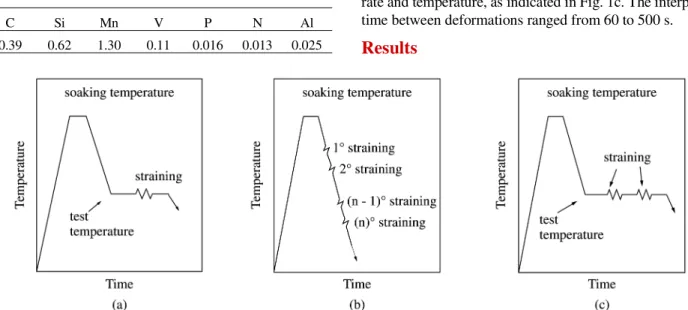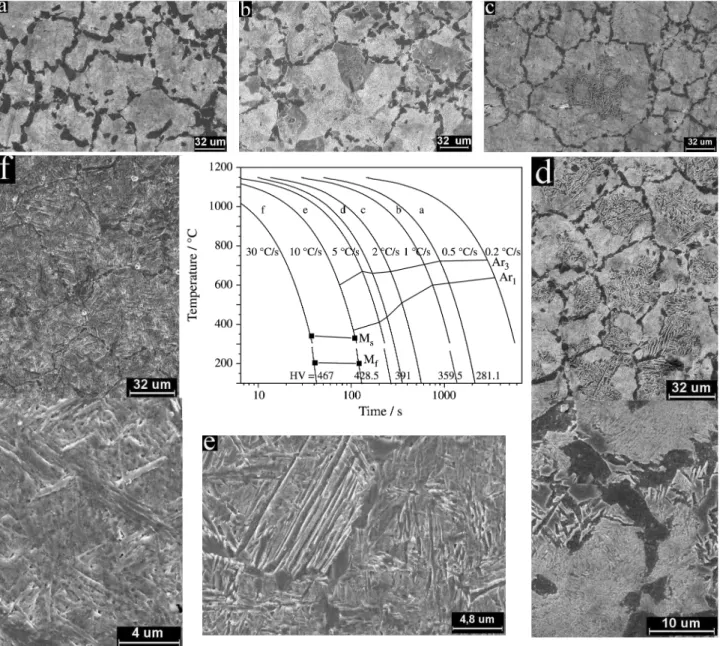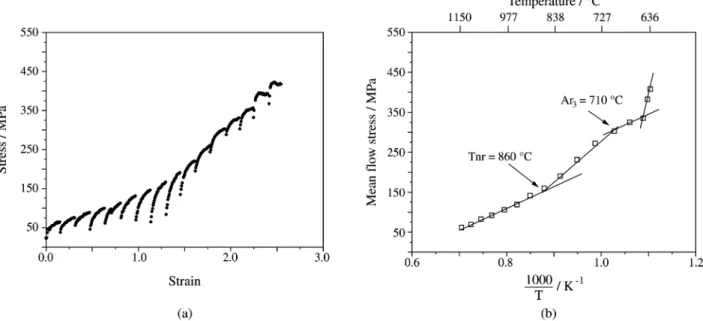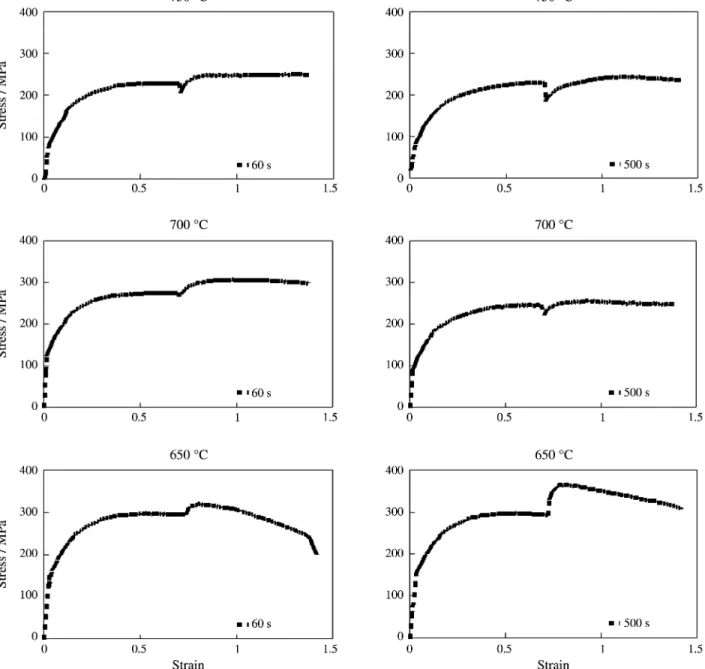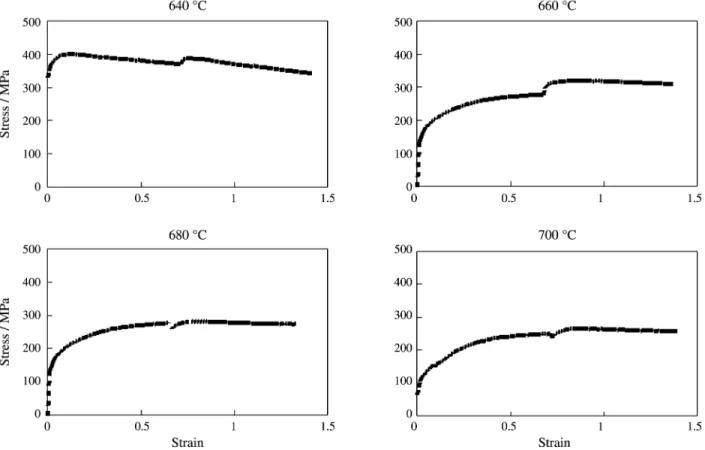Plastic Behavior of Medium Carbon Vanadium Microalloyed Steel
at Temperatures Near
γ ↔ α
Transformation
N.J. Lourençoa, A.M. Jorge Jr.a, J.M.A. Rollob, O. Balancina*
aDepartamento de Engenharia de Materiais,
Universidade Federal de São Carlos, São Carlos - SP, Brazil
bEscola de Engenharia de São Carlos,
Universidade de São Paulo, São Carlos - SP, Brazil
Received: July 7, 2000; Revised: June 28, 2001
Dilatometric techniques were used to build the continuous cooling transformation (CCT) diagram for a medium carbon microalloyed steel; the microstructure and hardness were determined at different cooling rates. The mechanical behavior of the steel in the austenite field and at temperatures approaching austenite to ferrite transformation was measured by means of hot torsion tests under isothermal and continuous cooling conditions. The no recrystallization temperatures, Tnr, and start of phase transformation, Ar3, were determined under continuous cooling condition
using mean flow stressvs.inverse of absolute temperature diagrams. Interruption of static recrys-tallization within the interpass time in the austenite field indicated that the start of vanadium carbonitride precipitation occurred under 860 °C. Austenite transformation was found to start at around 710 °C, a temperature similar to that measured by dilatometry, suggesting that interphase precipitation delays the transformation of deformed austenite. Pearlite was observed at temperatures ranging from 650 °C to 600 °C, with the flow curves taking on a particular shape,i.e., stress rose sharply as strain was increased, reaching peak stress at low deformation, around 0.2, followed by an extensive softening region after peak stress.
Keywords:microalloyed steel, gamma alpha transformation, hot working
1. Introduction
Micro additions of carbonitride formers in steels have been widely used in the production of plates, rolled bars and forged components. In conventional thermomechanical treatments of low carbon microalloyed steels, the main goal is to promote austenite grain refinement in the recrystalli-zation temperature range, combined with straining at tem-peratures below the startup of deformation-induced precipitation. The latter process is very effective because, during low temperature hot deformation, precipitates such as carbonitride particles stabilize the dislocation substruc-ture and retard recrystallization, thus facilitating ferrite refinement. In addition to producing the grain refinement effect, carbonitrides precipitated at austenite–ferrite/pear-lite interfaces in medium carbon vanadium microalloyed steels increase the mechanical strength of forged compo-nents, producing a precipitation strengthening effect in the range of 150-250 MPa1. In addition to increasing their strength, precipitation also decreases the toughness of
ma-terials. The toughness of medium carbon pearlite steels can be improved by increasing the ferrite volume fraction and by refining the constituent phases size. Phases constituent refinement may be attained by thermomechanical treat-ments under warm conditions, at temperatures approaching austenite decomposition2.
Mechanical tests have been widely used to simulate thermomechanical treatments in the design of convention-ally controlled working schedules for medium carbon mi-croalloyed steels3-5. To improve the control of austenite grain refinement, double straining tests have been made to investigate the kinetics of static recrystallization6-8. The limit between the full static recrystallization region and deformation-induced precipitation has been determined un-der different deformation conditions by means of multiple pass deformation tests performed under continuous cooling conditions9,10. Dilatometric techniques have been em-ployed at austenite decomposition temperatures to deter-mine con tin uo us cooling transfo rmatio n ( CCT) diagrams11-13. Although much attention has been focused
on conventionally controlled work, few systematic studies have been carried out to characterize the plastic behavior of these steels at temperatures close to the gamma alpha transformation.
The purpose of this work was to study the plastic behavior of a medium carbon vanadium microalloyed steel in the austenite field and in the phase transition region. Flow curves were determined under different deformation conditions and the shape and stress levels of these curves were associated with the microstructure present during straining.
2. Material and Experimental Procedures
The material used in this work was a commercial medium carbon vanadium microalloyed forging steel whose chemical composition is given in Table 1. To determine the CCT diagrams, dilatometry tests were carried out using 2 mm diameter, 12 mm long samples. The samples were heated at 2 °C/s up to the soaking temperature of 1150 °C and kept at this temperature for 10 min. Finally, they were cooled down at a rate ranging from 0.2 °C/s to 30 °C/s.
Mechanical tests were carried out on a computerized hot torsion machine14. The samples, having a 20 mm length and 6 mm diameter in the reduced central gage section, were heated by means of an infrared furnace mounted directly on the testing machine. Chromel-alumel thermocouples were used to measure and control the temperature. To prevent oxidation, the sample was enclosed in a 2% hydrogen argon atmosphere surrounded by a quartz tube. Data were col-lected by means of a software program that imposes
pa-rameter tests such as strain, strain rate, temperature, and interpass time between straining.
Three kinds of hot torsion tests were performed: isother-mal continuous tests, multiple pass tests under continuous cooling conditions, and isothermal double straining tests.
(a) Isothermal continuous tests. These tests were carried out to determine the plastic flow curves at different tem-peratures. Samples were heated from room temperature to the soaking temperature of 1150 °C, held at this tempera-ture for 10 min, cooled to the test temperatempera-ture at a rate of 1 °C/s, held for 1 min, and finally strained isothermally until fracture, as illustrated in Figure 1a. These tests were carried out over a temperature range of 600 °C to 1150 °C, and at equivalent strain rates of 0.3, 0.5 and 1.0 s-1.
(b) Multiple pass tests under continuous cooling condi-tions. The purpose of these tests was to investigate defor-mation-induced phenomena that may occur upon deformations schedule. Critical temperatures for the hot working process, Tnr and Ar3,were also determined. For
this kind of test, samples were heated from room tempera-ture to a soaking temperatempera-ture of 1150 °C and kept at this temperature for 10 min, followed by cooling at a rate of 1 °C/s, as indicated in Fig. 1b. The first straining was at 1120 °C and the elapsed time between deformations was 30 s.
(c) Isothermal double straining tests. These experiments were carried out to investigate hardening and softening processes that may occur after hot deformation. The sam-ples were heated from room temperature to a soaking temperature of 1150 °C and maintained at this temperature for 10 min, followed by cooling to test temperature at a rate of 1 °C/s, where they were held for 1 min before the first straining. After this straining followed by an unloading period, a second straining was applied at the same strain rate and temperature, as indicated in Fig. 1c. The interpass time between deformations ranged from 60 to 500 s.
Results
Table 1.Chemical composition of the steel tested (wt%)C Si Mn V P N Al
0.39 0.62 1.30 0.11 0.016 0.013 0.025
Start and finish transformation temperatures, under the continuous cooling conditions determined by dilatometry tests, are illustrated in the CCT diagram plotted in Fig. 2. The hardness and microstructures observed after cooling to room temperature at each cooling rate applied are also displayed in this figure. These data indicate that, at low cooling rates of less than 2 °C/s, the microstructure is composed of pro-eutectoid ferrite and pearlite. On the other hand, bainite is formed at cooling rates ranging from 5 °C/s to 10 °C/s, while martensite is observed at the highest cooling rates.
The plastic flow curves obtained by isothermal continu-ous tests with strain rates of 1.0 s-1are displayed in Fig. 3 and indicate that the level of stress depends on deformation temperature. Stress increases as temperature decreases, but
this increment is higher at lower temperatures. It is also worth noting that the shape of the flow curves changes as deformation temperature is altered. At high temperatures exceeding 700 °C, the flow curves show the characteristic shape expected for materials that soften by dynamic recrys-tallization. At lower temperatures, however, the curve has a peculiar shape: rapid work hardening to a hump, followed by an extensive flow-softening region.
In order to emphasize the differences in the shape of the flow curves at high and low temperatures, the dependence of peak stress and peak strain on deformation temperature was determined, as displayed in Figures 4 and 5. In addi-tion, the apparent activation energy was determined using the generalized hot-working relationship between peak stress and strain rate proposed by Sellars and Tegart15:
ε.eQ⁄RT=A [ sinh(α σ)]n=Z
whereε. is the strain rate;σthe peak stress; Q the activation energy for hot deformation; T the temperature; A,α, n, and R constants; and Z the Zener-Hollomon parameter. The fit of the experimental data to this equation is depicted in Fig. 6, which indicates a change in slope of the ln[sinh(ασ)]vs.
1/T curve, with the transition at 700 °C. The activation energies determined in the high- and low-temperature ranges were 332 and 593 kJ/mol, respectively.
Figures 4 and 6 indicate that the rise in the level of stress and the activation energy are greater at lower temperatures. Based on this observation, the plastic behavior of this steel can be separated into two regions: above and below 700 °C. The increased material strength at temperatures below 700 °C can be attributed to the presence of ferrite and pearlite, while the higher activation energy can be corre-lated with deformation in the multi-phase region16,17.
The influence of microstructural evolution on plastic flow during thermomechanical treatments can be seen more clearly through multiple pass tests under continuous cool-ing conditions. Figure 7a represents a sixteen pass testcool-ing schedule simulating hot plate mills with a cooling rate of 1 °C/s, an interpass time of 30 s, and 15% straining after soaking at 1150 °C. The dependence of the mean flow stress (MFS) on the inverse absolute temperature is shown in Fig. 7b. This figure clearly shows that the level of stress depends on deformation temperature, and that the slope of MFSvs.
1/T takes on four different values as deformation tempera-ture is decreased from 1150 °C to 600 °C with transition close to 860 °C, 710 °C and 650 °C.
At high temperatures, full recrystallization takes place and the increase in mean flow stress is solely due to the decrease in temperature. At temperatures below the Tnr (860 °C), there is only partial recrystallization or no recrys-tallization at all, and the mean flow stress increases more rapidly as temperature decreases. Below 710 °C, the changes in the slope are associated with the beginning of
Figure 3.Plastic flow curves determined under isothermal continuous conditions.
Figure 4.Dependence of the peak stress on deformation temperature.
Figure 5.Dependence of the peak strain on deformation temperature.
the formation of pro-eutectoid ferrite and pearlite. The mean flow stress increases less rapidly because ferrite is softer than austenite and, at lower temperatures, there is a sharp increase as pearlite begins to form.
Plastic behavior at low temperatures was investigated using double isothermal straining tests; Figure 8 displays data from tests performed at 750 °C, 700 °C and 650 °C. Some softening occurred in the interpass time at 750 °C, but the level of stress was greater in the second straining than it was in the first. The second deformation stress-strain curves maintained the shape of the first pass at higher temperatures, but there was a sharp change at 650 °C. The stress-strain curves for the first pass were typical for mate-rials that soften by dynamic recrystallization, whereas the second pass was characterized by rapid work hardening followed by extensive flow softening. Figure 9 confirms this trend and indicates that the transition occurred around 650 °C.
Discussion
The equilibrium solution temperature for vanadium ni-tride in this steel, evaluated from the equation given by Narita18: Ts(K) = 8700/(3,63 - log(V.N)), is estimated to be
1067 °C. Thus, for all the experiments carried out in this work, austenite with most of the vanadium in solid solution having grain size around 100µm10was subjected to differ-ent thermomechanical treatmdiffer-ents. Carbonitride precipita-tion took place upon straining on cooling, depending on the experimental conditions imposed. However, at room tem-perature, every sample that was cooled at a rate of 1 °C/s shown a ferrite-pearlite microstructure, see Fig. 2.
Precipitation during thermomechanical treatments can be detected by its effects on stress-strain curves; the
precipitate hardens the microstructure,increasing the flow stress level. As an example, Fig. 7b shows an increase in the slope of mean flow stressvs.inverse of temperature diagram, as deformation temperature drops below the Tnr. In this case, it has been well established that defor-mation-induced precipitation delays static recrystalliza-tion during the holding time between consecutive deformations, leading to the accumulation of deforma-tion from pass to pass19.
It is worth noting, however, that, in the same range of temperatures, the increase in the slope of peak stressvs.1/T curve is not observed in Fig. 4. In this case, straining was carried out after cooling from soaking temperature to test temperature. Even though straining was applied below the Tnr, precipitation did not occur because static precipitation is rather sluggish. A similar interpretation holds true in the analysis of the role of interpass time in the tests carried out isothermally with double straining. At 700 °C and 750 °C, the level of stress is somewhat higher at the second straining than at the first; here, precipitation took place in the inter-pass time.
Precipitation during multiple pass deformation affects the behavior of austenite in different ways. During lower temperature hot deformation, precipitation in austenite sta-bilizes the dislocation substructure, inhibiting the restora-tion processes. The stored energy expands the potential nucleation sites and raises the Ar3. On the other hand, as
straining) under continuous cooling conditions, showed that the expected difference was not achieved. Both data indicate similar values,i.e., around 710 °C. Bearing in mind that this steel had a high vanadium, carbon and nitrogen content, certainly the potential for carbonitride precipita-tion is not spent during austenite deformaprecipita-tion, and inter-phase precipitation does take place during transformation. Thus, interphase precipitation during transformation can retard the progress of transformation by pinning interfaces. Although precipitation has been observed by electron microscopy in pearlitic ferrite lamellas in medium carbon vanadium microalloyed steels20, it proved impossible to distinguish its effect in this study because both pearlite
associated with epheroidization21 and/or breakage of the perlitic cementite lamellas, along with the loss of coherence as straining progresses17.
Conclusions
In the austenite field, the medium carbon vanadium microalloyed steel studied here displayed stress-strain curves with the characteristic shape expected for materials that soften by dynamic recrystallization, and exhibiting an activation energy for hot deformation of 332 kJ/mol was found.
When subjected to a deformation schedule under con-tinuous cooling conditions, this steel showed the no recrys-tallization temperature at 860 °C, indicating that deformation-induced precipitation took place within the austenite field.
Similar values measured for Ar3 with and without
straining suggest that interphase precipitation occurred dur-ing transformation, retarddur-ing the progress of transforma-tion by pinning interfaces.
At low hot working temperatures, when the microstruc-ture consisted of pro-eutectoid ferrite and pearlite, the flow curves had a peculiar shape: rapid work hardening to a hump, followed by an extensive flow-softening region.
Acknowledgements
The financial support of the Brazilian research funding agencies FAPESP and CNPq is gratefully acknowledged.
References
1. Wright, P.H.Advanced Materials Processes, v. 12, p. 29-34, 1988.
2. Tostenson, D.; Bertolo, R.; Glasgal, B.Fundamentals and Application of Microalloying Forging Steels, Tyne, C. J.; Krauss, G.; Matlock, D.K., eds., TMS (Minerals, Metals & Materials Society), p. 327-344, 1996.
3. Meyer, L.; Müschenborn, W.; Schriever, U. Ther-momechanical Processing in Theory, Modeling and Practice, Hutchinson, B.; Andersson, M.; Engberg, G.; Karlsson, B.; Siwecki, T., eds., ASM Sweden, Stockholm, p. 93-120, 1996.
4. Engineer, S.; Huchtemann, B.; Schüler, V.Steel Re-search, v. 58, p. 369-376, 1987.
5. Peñalba, F.; Zapiráin, F.; Carsí, M.; Garcia de Andrés, C.; Andrés, M.P. Mater. Sci. Forum, v. 94-96, p. 689-696, 1992.
6. Medina, S.F.; Lopez, V.ISIJ Int., v. 33, p. 605-614, 1993.
7. Santos, J.M.R.Tese de Doutorado, Universidade Fed-eral de São Carlos, 1997.
8.
Quispe, A.; Medina, S.F.; Valles, P.ISIJ Inter., v. 37, p. 783-788, 1997.
9. Revidriego, F.J.; Abad, R.; López, B.; Gutiérrez, I.; Urcola, J.J.Scri. Mater., v. 34, p. 1589-1594, 1996. 10. Souza, R.C.Tese de Doutorado, Universidade Federal
de São Carlos, 1996.
11. Peñalba, F.; Garcia de Andrés, C.; Carsí, M.; Zapirain, F.J.Mater. Sci., v. 31, p. 3847-3852, 1996.
12. Zhang, F.; Boyd, J.D.Fundamentals and Applications of Microalloying Forging Steels, Tyne, C.J.; Krauss, G.; Matlock, D.K., eds., TMS (Minerals, Metals & Materials Society), p. 127-141, 1996.
13. Dong, H.; Li, G.; Lu, Z.Fundamentals and Applica-tion of Microalloyed Forging Steels, Tyne, C. J.; Krauss, G.; Matlock, D. K., eds., TMS (Minerals, Metals & Materials Society), p. 549-560, 1996. 14. Jorge Jr., A.M.; Balancin, O.Revista de Engenharia e
Ciências Aplicadas, v. 2, p. 133-137, 1994/1995.
15. Sellars, C.M.; McG.Tegart, W.J.Mem. Sci. Rev. Met-all., v. 63, p. 731-740, 1966.
16. Briottet, L.; Jonas, J.J.; Montheillet, F.Acta Mater., v. 44, p. 1665-1672, 1996.
17. Balancin, O.; Hoffmann, W.A.M.; Jonas, J.J.Metall. Mat. Trans., v. 31A, p. 1353-1364, 2000.
18. Narita, K.ISIJ Int., v. 15, p. 145-153, 1975.
19. Borato, F.; Barbosa, R.; Yue, S.; Jonas, J.J. THER-MEC-88, Tamura, I., ed., Tokyo, v. 1, p. 383-390, 1988.
20. Edmonds, D.V. Fundamentals and Applications of Microalloying Forging Steels, Tyne, C.J.; Kraus, G.; Matlock, D.K., eds., TMS (Minerals, Metals & Mate-rials Society), p. 111-125, 1996.
21. Harrigan, M.J.; Sherby O.D.Mater. Sci. Eng., v. 7, p. 177-189, 1971.
